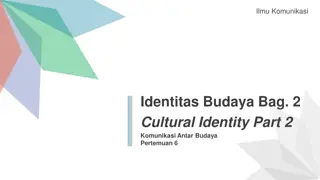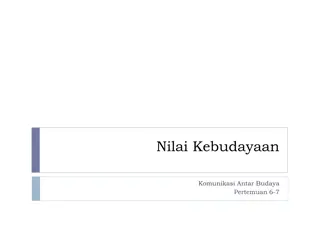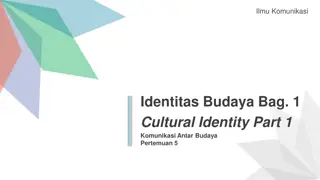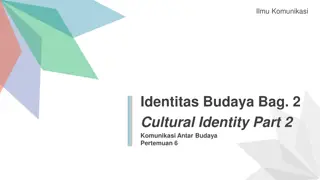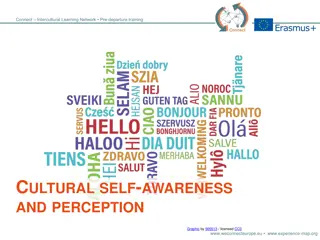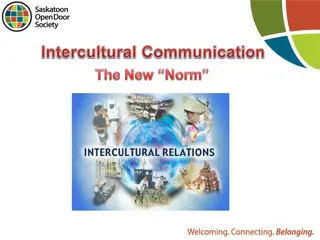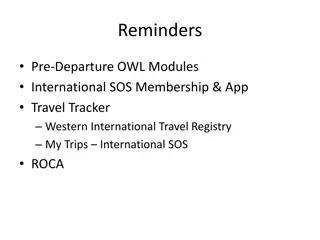Intercultural Communication in Business: Understanding Cultural Dynamics
Explore the complexities of intercultural communication in the global marketplace, discussing cultural characteristics, ethnocentrism, and the importance of tolerance, understanding, and openness to differences. Learn how to navigate communication challenges and integrate diverse perspectives effectively.
Download Presentation

Please find below an Image/Link to download the presentation.
The content on the website is provided AS IS for your information and personal use only. It may not be sold, licensed, or shared on other websites without obtaining consent from the author.If you encounter any issues during the download, it is possible that the publisher has removed the file from their server.
You are allowed to download the files provided on this website for personal or commercial use, subject to the condition that they are used lawfully. All files are the property of their respective owners.
The content on the website is provided AS IS for your information and personal use only. It may not be sold, licensed, or shared on other websites without obtaining consent from the author.
E N D
Presentation Transcript
Talking Business Chapter 3: Intercultural and International Communication Unless otherwise noted, this work is licensed under a Creative Commons Attribution-NonCommercial- ShareAlike 4.0 International (CC BY-NC-SA 4.0) license. Feel free to use, modify, reuse or redistribute any portion of this presentation.
Learning Outcomes At the end of this chapter, learners will be able to: Define Culture Define intercultural communication Discuss the effects of ethnocentrism. List several examples of common cultural characteristics. Describe international communication and the global marketplace Give examples of various styles of management, including Theory X, Y, and Z.
3.1 Intercultural Communication Culture is the ongoing negotiation of learned and patterned: Beliefs Attitudes Values Behaviours Photo by geralt, Pixabay License
3.1 Intercultural Communication Ethnocentrism prevents you from bridging the gap with others and increases intolerance of difference. In business and industry, you need: Tolerance Understanding Patience Openness to difference Image by Augusto Ord ez, Pixabay License
3.1 Intercultural Communication Intercultural communication is communication between people with differing cultural identities. Understand Intercultural communication: Compare cultures Shift to local perspective You don t have to know everything to know something There are rules we can learn Experience counts Perspectives can differ Intercultural communication can be applied to international business Intercultural communication integrates disciplines
3.2 Common Cultural Characteristics Five common cultural characteristics: Rites of initiation Common history and traditions Common values and principles Common purpose and sense of mission Common symbols, boundaries, status, language, and rituals
3.3 Divergent Cultural Characteristics Cultures are distinct when it comes to: Rules Uncertainty Time and time horizons Directness Materialism Power distance Photo by Gerd Altmann, Pixabay License
3.4 International Communication and the Global Marketplace International Communication and the Global Marketplace Fig 3.1 Components of the Global Village
3.4 International Communication and the Global Marketplace What is the Global Village? Information and transportation technologies reduce the time and space required to interact. Photo by Gerd Altmann, Pixabay License
3.5 Styles of Management Theory X Workers: Are motivated by basic needs. Have a general disposition against labour. Need constant, direct supervision Managers: Are authoritarian, autocratic. Do no seek input/feedback from employees. Use control and incentive programs to provide punishment and reward. Photo by JL G, PixabayLicense
3.5 Styles of Management Theory Y Workers: Are ambitious, self-directed, capable of self motivation. Managers: Think that a job well done is a reward. View employees as a valuable source of feedback. Value collaboration. Believe workers need little supervision. Photo by JL G, PixabayLicense
3.5 Styles of Management Theory Z Workers: Have a high need for reinforcement. Emphasize belonging. Are trusted to do their jobs with excellence. Managers: Are trusted to support their workers. Photo by JL G, PixabayLicense
Reflection Activity After learning more about cultural differences in business contexts, what advice do you have for Abe, where her country of origin culture and customs are different from the new Canadian customs she encounters? Should she assimilate and just shake hands with male colleagues? If it s important for her to maintain some of her customs, how might she communicate about that with her new colleagues?




